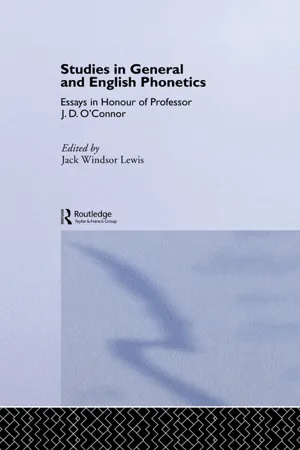Languages & Linguistics
Palatal
Palatal refers to sounds produced by raising the middle part of the tongue towards the hard palate, which is the front part of the roof of the mouth. In linguistics, palatal sounds are often characterized by the tongue's proximity to the hard palate during articulation, and they are found in various languages around the world.
Written by Perlego with AI-assistance
5 Key excerpts on "Palatal"
- eBook - ePub
- Jethro Bithell(Author)
- 2018(Publication Date)
- Routledge(Publisher)
r (das Zungen-r). This is formed by vibration of the tip of the tongue (it is therefore coronal) behind the upper teeth (postdental position) or the upper teeth-ridge (postalveolar position); the essential is that the tip should vibrate freely in the current of air as it passes through the mouth.(e) The alveolar sounds [∫] and [Ʒ] are articulated by the tip and blade of the tongue raised to the teeth-ridge.2. Region of the Palate (Gaumengebiet). Sounds formed by contact with the hard palate are Palatals (Vordergaumenlaute, Hart-gaumenlaute, Palatale), sounds formed against the soft palate are velars (Hintergaumenlaute, Weichgaumenlaute, Velare, ‘Gutturale’). The corresponding adjectives are: Palatal =Palatal, mittelgaumig; velar = velar, hintergaumig.There are no normal German sounds formed against the front part of the hard palate. If we remember this, we may freely use the term Hochgaumenlaute (p. 54, n. 2) for Palatals. Sounds formed in other languages against the front part of the hard palate are called cerebrals (Zerebrale, Zerebrallaute), so called because to Indian grammarians (see p. 12) the sounds seemed to come from the brain; the other common term2 for them, ‘cacuminals’ (Kakuminale, Kakuminallaute), ‘roof-of-the-mouth sounds’, is nearer the truth. A more suitable term is vorderste Hartgaumenlaute; in English simply ‘inverted sounds’. Cerebrals were common in Sanscrit, and are still common in the modern Indian dialects. In forming cerebrals the tip of the tongue is turned upwards and bent backwards (‘reverted’), with its under side to the hard palate. In Swedish, cerebral (or ‘retroflex’) t, d, n, l and s occur after r (in such words as fart, bord, Karl, korn, kors). Cerebral r—called ‘inverted’ or ‘reverted’ r—occurs dialectically in the South of England. In Central Germany the ich sound [ç] is often formed in the cerebral position; it then sounds like sch - eBook - ePub
- Steve Kleinedler(Author)
- 2018(Publication Date)
- Routledge(Publisher)
pat , the vocal folds don’t vibrate.This stream of expelled air is modified by parts of your body in your mouth and near the inside of your mouth. (The inside of your mouth is also called the ORAL CAVITY .) The parts of the body that modify this air stream are called ARTICULATORS . These articulators include the:- lips,
- teeth,
- tongue,
- HARD PALATE (the bony part of the roof of your mouth),
- SOFT PALATE (the soft part of the roof of your mouth past the bony part – this part is also called the VELUM ), and
- PHARYNX (the part of your mouth past the soft palate but before the esophagus).
One way that consonants are categorized is by the place in the mouth where they are articulated.Something you can do!- With the tip of your tongue, touch your lips, teeth, and hard palate.
- Raise the broad, flat part of your tongue or the back of your tongue to meet the soft palate.
- Pull the back of your tongue backward past the soft palate to meet the pharynx.
- What happens when you try to make sounds when your tongue is in each of these positions? We’ll return to this exercise again at the end of the chapter.
- Consonants that are articulated with the lips are called LABIALS . They include [p], [b], and [m].
- Consonants that are articulated with the tongue against the ridge of the roof of your mouth, just above your upper teeth, are called ALVE OLARS . They include [t], [d], and [n]. (This ridge is where the sockets of your teeth are located in the jaw. It is called the ALVEOLAR RIDGE .)
- Consonants that are articulated when the tongue and the velum meet are called VELARS . They include [k], [g], and [ŋ] (the sound represented by the letters ‘ng’ in words like runni ng .) In English, [ŋ] never appears at the beginning of the word; however, in many other languages, it can.2
2.2 Kinds of speech soundsShortly after you learned the alphabet, you were likely taught that the letters of the alphabet were either consonants or vowels. Generally speaking, a VOWEL is created when you produce a steady, unobstructed flow of air. When you produce a CONSONANT - eBook - ePub
Studies in General and English Phonetics
Essays in Honour of Professor J.D. O'Connor
- Jack Windsor Lewis(Author)
- 2012(Publication Date)
- Routledge(Publisher)
Figure 2.1 . The zoning and labelling are almost identical to those proposed by Firth (1957: 151). This method of division has the advantage of being based on objective criteria and seems to tally well with traditional landmarks when transferred to the mid-sagittal profile (cf. e.g. Catford 1977: 143; Ladefoged and Maddieson 1986: 4). In particular, the border between the alveolar and postalveolar zones, as defined by the dentition, usually falls at the variously named ‘edge’, ‘corner’ or ‘peak’ of the alveolar ridge, in so far as one is discernible from the mid-sagittal profile. Also, the border between the hard palate and the velum at the midline (usually clearly visible on at least some of the photographs) almost always falls exactly on the line between the middle and back molars (7 and 8). Contact between tongue and palate on the sagittal cross-sections is marked according to the location of contact at the midline on the corresponding palatogram. The outline of the rest of the tongue (i.e. the part not in contact with the palate), however, is no more than a reasonable estimation of the shape of the tongue along the midline at the moment of maximum constriction, based on anatomical knowledge, phonetic experience and common sense.Figure 2.1 Anatomically defined tectal zones used in describing the location of tongue contact on palatogramsIn those languages, and in those contexts, where an APICAL contrast is made (i.e. between ALVEOLAR and POSTALVEOLAR sounds), static palatographic data from the present study show the ALVEOLAR sounds to be articulated in a quite similar fashion by almost all speakers. Figure 2.2 illustrates the way these sounds are produced in intervocalic position by speakers of five different double-APICAL languages. There is usually quite a narrow band of contact at the alveolar ridge, close behind the upper front teeth. This contact extends back along the midline of the palate to a depth of only 2–7 mm, sometimes intruding slightly into the postalveolar zone, and continues around the rim of the palate, usually broadening out to overlap the teeth at the sides. Both the narrowness of the contact and also the evidence from linguagrams indicate that the active articulator for all these speakers must be the tip of the tongue. Figure 2.5a shows a typical ALVEOLAR linguagram in which it can be seen that only the very tip and rim of the tongue have been in contact with the palate. Canonical APICAL ALVEOLARS - eBook - ePub
- Phil Rose(Author)
- 2002(Publication Date)
- CRC Press(Publisher)
the two sounds in the labio-dental fricative cell [f] is voiceless and [v] voiced, and of the two sounds in the bilabial plosive cell [p] is voiceless and [b] voiced. As far as the English plosives go, it is somewhat of an oversimplification to say there are only two phonetic variants, and that they differ in voicing. This will be taken up later.Table 6.2 shows that phonetically English has plosives at three places: bilabial, alveolar and velar, plus affricates at the post-alveolar place (these are commonly referred to as palato-alveolar, or even Palatal, affricates).Phonetically, there are fricatives at five different places; nasals at four places; one lateral; one rhotic (‘r’ sound); and two semivowels. Except for the higher number of fricatives at the front of the mouth (labio-dental, dental and alveolar), this is a fairly typical phonetic consonantal inventory.The lateral requires additional comment. The symbol [ɫ] stands for a velarised lateral (a non-velarised, or plain lateral would be transcribed [l] ). This introduces an additional complexity called secondary articulation. It is possible with consonants produced with the tip of the tongue simultaneously to independently control the position of the tongue body to produce different sounds. In the case of the velarised lateral, in addition to its apico-alveolar place (and lateral manner), it is typically made with the body of the tongue raised towards the soft palate or velum.The tongue body is not the only articulator that can be independently controlled in secondary articulation. Lip activity is also common: the ‘sh’ sound in English words like sheet shut shark is usually produced with slightly rounded lips, for example. The reader can also try producing a voiceless alveolar fricative ( [s] ) with and without rounding their lips to notice the difference in sound (rounding lowers the pitch). The ending -ised, as in velarised, is often used to refer to secondarily articulated sounds; thus sounds secondarily articulated with lip rounding are called labialised.Vowels
Vowels are important in forensic phonetics, for several reasons. As will be shown in Chapter 8, their acoustical properties are relatively robust and easy to quantify. This is not only because they tend to last longer – have greater duration – than consonants, but also because of their relatively well-defined acoustic structure. (Vowels belong to the class of speech sounds called sonorants that are defined by precisely this characteristic.) Vowels are the speech sounds from whose acoustics the imprint of the vocal tract that produced them can be most easily extracted. Some vowels have been shown to have considerable individual-identifying potential. - eBook - ePub
- Bruce M. Rowe, Diane P. Levine(Authors)
- 2022(Publication Date)
- Routledge(Publisher)
Articulation is the production of speech sounds by the movement of the speech organs. We have noted that once out of the glottis, the airstream may or may not be obstructed in the cavity above the glottis. If it is not obstructed, we have a vowel; if it is obstructed, then we have a consonant. The following paragraphs list some of the “landmark” areas used in English to differentiate sound based on the place of articulation. We use the word “landmark” because various sounds can usually be produced in more than one way. The exact place of articulation for a specific sound will vary from person to person and even from time to time for an individual. Furthermore, sounds that we perceive as being the same often are not the same in acoustic terms. In the listing of places of articulation, English consonants are used as examples. Speakers of other languages may form sounds at articulatory locations not used in English.Articulation is the production of speech sounds by the movement of the speech organs.Bilabials are produced by bringing the lips together. This place of articulation can easily be illustrated by noting the position of the lips for the initial sounds in such words as pool, boot and money. These sounds are phonetically represented by [p], [b], and [m], respectively.Labiodentals, the initial sounds in five, fine, vim, and vine, are produced by raising the lower lip until it comes near the upper front teeth. The three bilabials, [p], [b], and [m], and the two labiodentals, [f] and [v], are sometimes grouped together under the general designation of labials.Dentals are articulated by the tongue and teeth, in contrast to the labiodentals, which involve the articulation of the lower lip and teeth. The two dentals in English are found in the initial sounds in think and then. When you make one of these th sounds, your tongue may go either between the top and bottom teeth or behind the top front teeth. Because both ways are the usual place for producing these sounds, the term dental would seem better than the alternative term, interdental, sometimes used to describe the th sounds. Interdental
Index pages curate the most relevant extracts from our library of academic textbooks. They’ve been created using an in-house natural language model (NLM), each adding context and meaning to key research topics.
Explore more topic indexes
Explore more topic indexes
1 of 6
Explore more topic indexes
1 of 4




